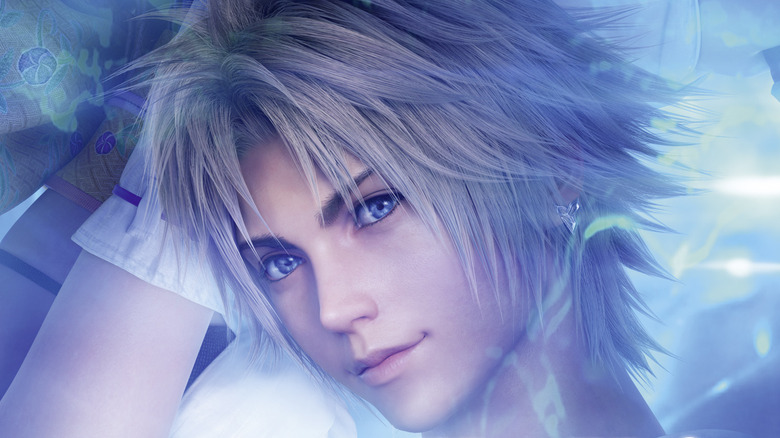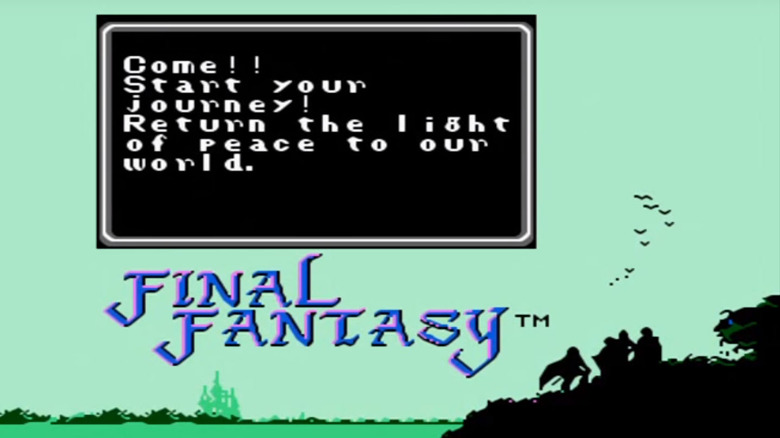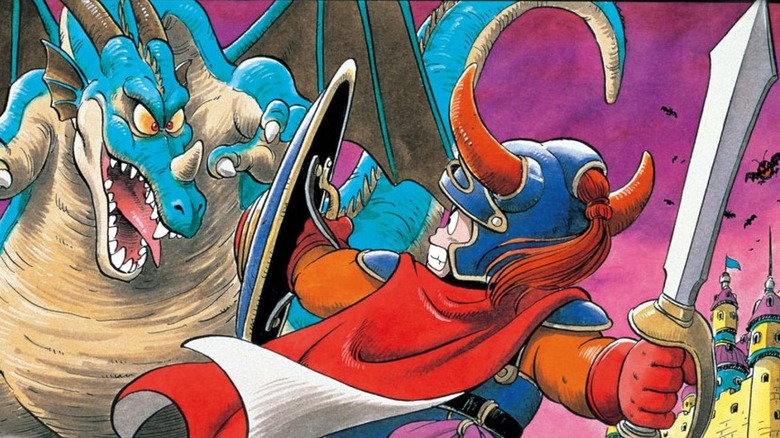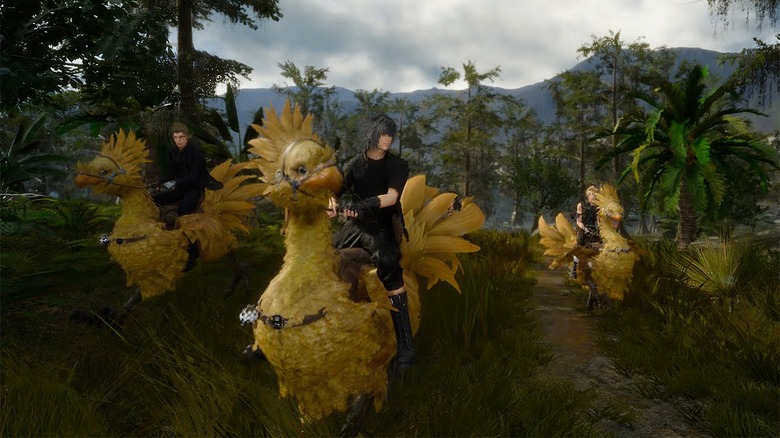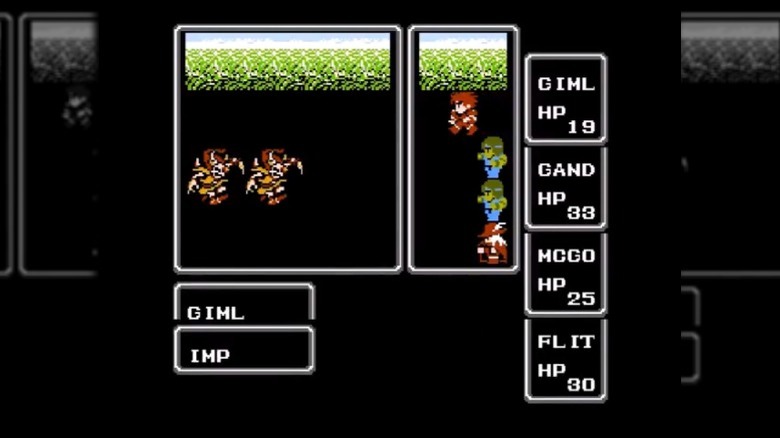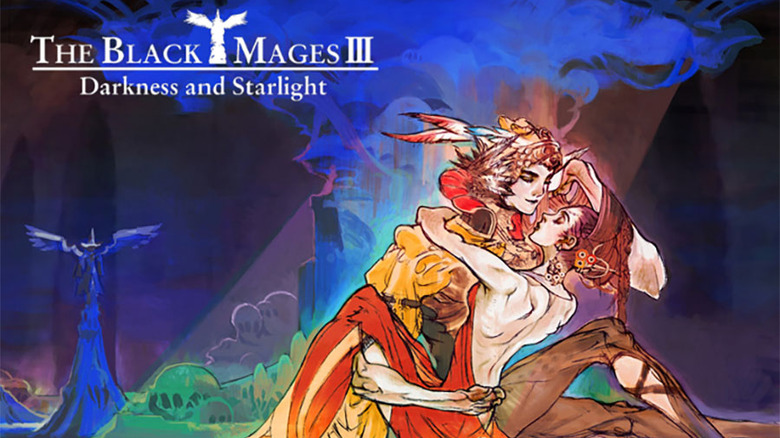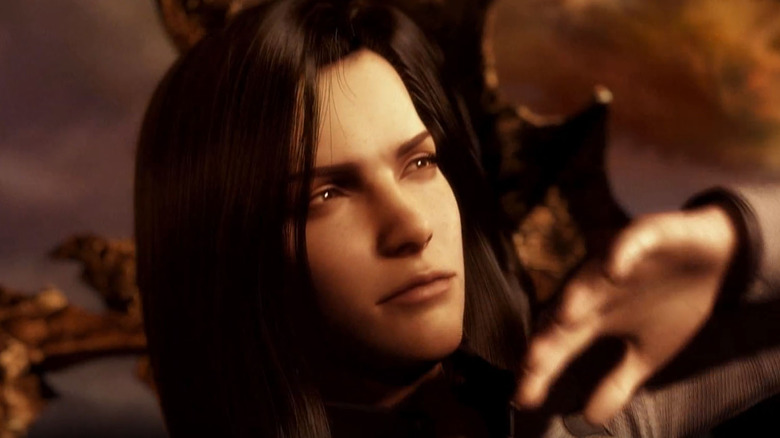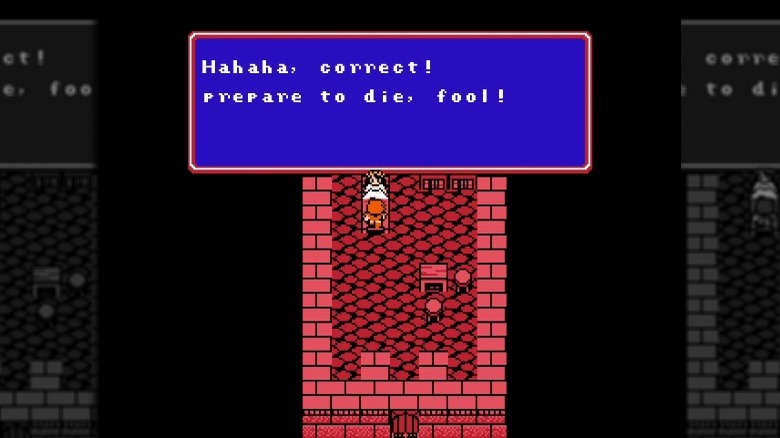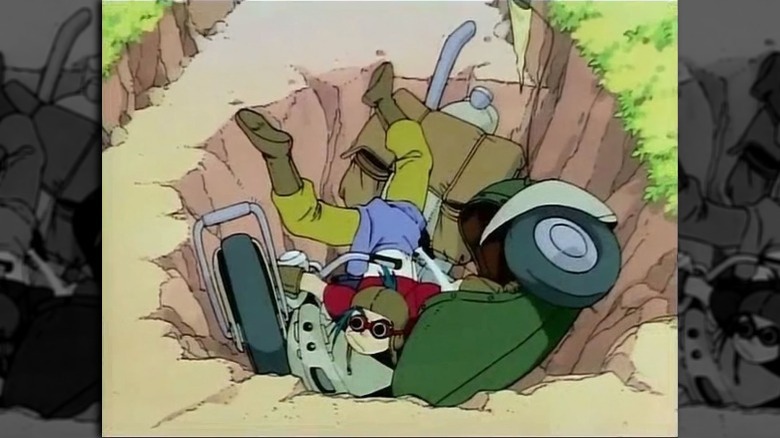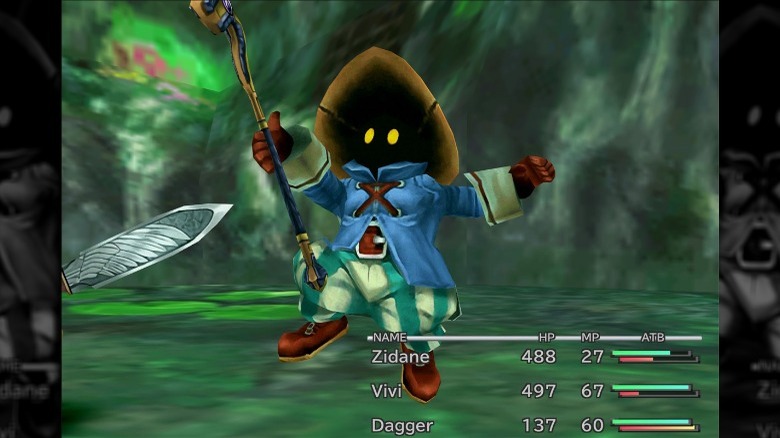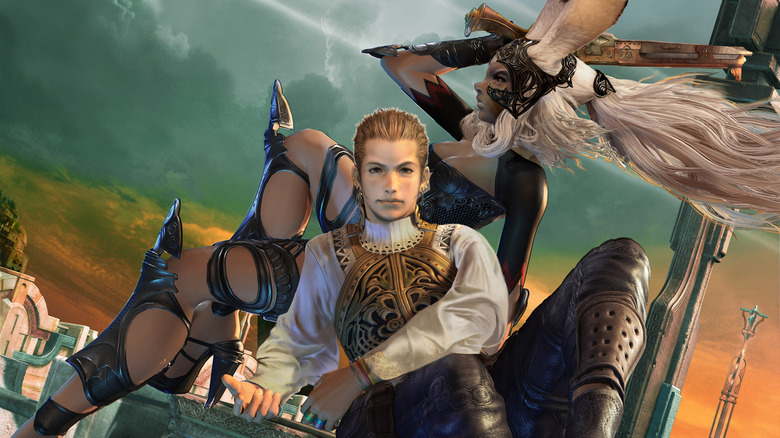The Untold Truth Of Final Fantasy
When did you first fall in love with Final Fantasy? Was it the first time that you hopped on top of a chocobo, or the first time that a moogle asked you to dance? Were you blown away by the cinematic spectacle of AVALANCHE's attack on Midgar's Mako Reactor, or did you find Tidus and Yuna's tragic love story tugging at your heartstrings? Maybe you're more into Final Fantasy's gameplay. That's fine. You can spend hours exploring Final Fantasy XV's detailed open world, and Final Fantasy V's endlessly flexible job system will keep you busy for weeks.
With over 30 years of history and close to 100 games to its name, Final Fantasy has a little bit of something for everyone. It's one of the most famous franchises in gaming for a reason. Still, some of the series' biggest secrets aren't hidden Final Fantasy's dungeons, fortresses, and castles. They're tucked away in interviews, media tie-ins, and behind-the-scenes stories. Expect more to come. Even after all this time, Final Fantasy just keeps going. There's nothing final about it.
Everything that you know about Final Fantasy (the name) is wrong
If you've been on the gaming internet long enough, you've probably heard the story: Final Fantasy got its name because it was probably going to be the last game that Square ever made. As the tale goes, when Final Fantasy was in production, Square was teetering on the edge of bankruptcy. Final Fantasy was all set to be its swan song.
It's a great bit of trivia. It's also not true. In 2015, Final Fantasy creator Hironobu Sakaguchi gave a talk on the history of Japanese role-playing games, and he took the opportunity to finally set the record straight. As reported by Kotaku, Sakaguchi and his team simply wanted a title that could be abbreviated as "FF." The Japanese pronunciation of FF, "efu efu," sounds particularly pleasant to Japanese speakers. From there, Square had to come up with the actual title. Fantasy was a natural selection, given the game's theme. However, Sakaguchi's first choice, "Fighting Fantasy," was already taken by a popular series of game books, so Square went with "final" instead. Really, any f-word would've worked.
Now, Sakaguchi has admitted that Square wasn't in great shape before Final Fantasy came out, and mentioned in an earlier interview that, if the game had tanked, he would've quit development and gone back to college. It's easy to see where the original story came from. Final Fantasy didn't fail, of course — since the original game debuted in 1987, Square has sold over 135 million Final Fantasy games — and Sakaguchi's career was set. The game industry has never been the same.
Like Final Fantasy? Thank Dragon Quest
Now, Final Fantasy is one of the best-known video game franchises in the world, but it almost didn't happen. While Hironobu Sakaguchi had wanted to make a role-playing game for years, Square wouldn't approve the project. They simply didn't think it would sell.
Dragon Quest changed that. Released by Enix in 1986, Dragon Quest used techniques like a deep character-driven storyline, save states (which weren't standard at the time), humor, and art by Dragon Ball creator Akira Toriyama to bring computer RPGs to as wide an audience as possible. It worked. Dragon Quest sold well — really, really well — and while the series didn't enjoy similar success in the United States, its Japanese reception was good enough that Square decided to let Sakaguchi make his own RPG game.
Even after that, Dragon Quest continued to inform Final Fantasy's development. Enix's RPG might've gotten Sakaguchi the green light, but the developer didn't want to make a simple Dragon Quest clone. In fact, as he tells 1UP, his main goal while designing Final Fantasy was to make the game as different from Dragon Quest as possible. "The graphics were part of that effort," Sakaguchi says, "as was the game setting with the Crystals." The two franchises went on to compete against one another for years, although these days, they're more like siblings than blood rivals. In 2003, Square and Enix merged, forming Square Enix and bringing Japan's two biggest role-playing game series under one roof.
Chocobos are total rip-offs
If the Final Fantasy series has a mascot, it's the chocobo. The giant yellow avians, which function more like horses than birds in Final Fantasy's quirky world, have been a part of Final Fantasy lore since Final Fantasy II. They've appeared in every single game in the main series since then, and even have their own spin-off series, Chocobo's Mysterious Dungeon.
While Square veteran Koichi Ishii, who also created the company's Mana series, designed the chocobos, they're not exactly original. Final Fantasy experts have traced the chocobo's origins back to two sources. One is a Japanese treat. In Japan, a character named Kyorochan has served as the mascot for Morinaga & Company's ChocoBalls, which are spherical chocolate-covered wafers with peanuts, caramel, or strawberry seeds stuffed inside. Like the chocobo, Kyorochan is a bird, and like the chocobo, his catchphrase is "Kweh!" As former Square Enix employee Hiromichi Tanaka notes, the ChocoBall probably gave chocobos their name, too. After all, "chocobo" is just a mash-up of "chocolate" and "ball."
Chocobos also owe a big debt to beloved anime director Hayao Miyazaki, particularly Nausicaä of the Valley of the Wind, his break-out title. In Nausicaä, characters ride on giant birds called horseclaws, and if they look familiar, that's not accident. Sakaguchi has flat-out admitted that Final Fantasy's mounted creatures were borrowed from Miyazaki's manga and its big-screen counterpart. That's not the only Miyazaki influence in Final Fantasy, either. You ever wonder why Final Fantasy has so many airships? It's all thanks to Miyazaki's Laputa: Castle in the Sky, which features the aircraft in a major way.
Hut, hut, attack!
Outside of Chocobo races and Blitzball, you don't really associate Final Fantasy with traditional sports. The games' developers do, however. Final Fantasy's battle system might seem like a riff on the stat and dice-driven combat found in tabletop RPGs like Dungeons & Dragons. Final Fantasy's developers, however, say that the game's has much more jock-friendly origins: American football and Formula One racing.
Final Fantasy's football parallels have been there since the very beginning. Battle system designer Hiroyuki Ito hadn't played many RPGs (computer or tabletop) before working on Final Fantasy, and struggled to come up with an elegant model for fighting. The NFL provided the answer. In both Final Fantasy and football, the sides trade off between offense and defense. Like a quarterback choosing plays, Final Fantasy players make their decisions before the action unfolds and hope that their strategies hold up. "In the NFL, the plays are pre-planned," Ito explains. "Each side has a strategy. That's kind of the idea."
The Formula One influence came a little later. According to Takashi Tokita, lead designer on Final Fantasy IV and co-director on Chrono Trigger, Ito was watching a race and saw some cars pass each other. Inspiration struck. Giving different characters different speeds helps differentiate them from one another, Ito decided, while adding a time-based element to combat could add some extra tension and open new gameplay opportunities. The end result, the Active Time Battle system, ended up driving combat in Final Fantasy IV through IX, as well as Final Fantasy X-2, Chrono Trigger, and more modern RPGs like Square Enix's I Am Setsuna.
The guy who wrote Final Fantasy's most famous tunes had his own Final Fantasy cover band
Final Fantasy wouldn't be the same without its music, which is some of the best in video games, period. That's largely due to the influence of one Nobuo Uematsu. Not only has Mr. Uematsu provided music for every main Final Fantasy game outside of Final Fantasy XIII (he was too busy with Final Fantasy XIV to help), but live performances of his music sell out concert halls around the world. He's been called both the Beethoven and John Williams of the video game industry. The dude is just that good.
Uematsu must like his music just as much as everyone else, too, because in 2002 the composer teamed up with fellow Square employees Kenichiro Fukui and Tsuyoshi Sekito to form The Black Mages, a rock band that performs covers of Uematsu's Final Fantasy themes. The Black Mages' first album hit a year later. Over the next eight years, Uematsu and his team released two more albums, occasionally performed live, and contributed tracks to Final Fantasy VII: Advent Children and the soundtrack for Final Fantasy III's 3D remake, bringing everything full circle.
The Black Mages dreamed about performing both original compositions and other game music but Uematsu says, because Square Enix owned the band's name, they were only allowed to play Final Fantasy songs. That ended up being the band's downfall. The Black Mages disbanded in 2010, and Uematsu quickly replaced them with The Earthbound Papas, a group that has the freedom to perform all of Uematsu's music, Final Fantasy or otherwise.
The worst Final Fantasy helped inspire one of BioWare's best games
Not every Final Fantasy title is great. That's okay. A few clunkers are bound to sneak through. The franchise's biggest flop, however, isn't a game. It's a movie that came out in 2001, and it's just as terrible as you've heard.
Despite The Spirits Within's state-of-the-art animation, which still holds up pretty well, critics slammed the movie's plot, while fans complained that the movie has very little to do with the Final Fantasy video games, despite series creator Hironobu Sakaguchi sharing co-directing duties. These days, The Spirits Within is best known as a colossal failure. Not only did the movie fail to recoup its $137 million budget, costing Square over $50 million, but it tanked Square's brand new movie studio, Square Pictures, and almost scuttled the merger between Square and Enix.
And yet, The Spirits Within's legacy lives on — just not at Square Enix. Instead, The Spirits Within served as a major influence on Mass Effect, BioWare's series of blockbuster sci-fi RPGs. In an interview with Xbox World 360, art director Derek Watts said, "The way they did their ship — that was kind of like in some of the early designs for the Normandy." He continues, "Our attack helicopters are loosely based off that movie ... Their glowing GUI screens; we used those a lot." In fact, Watts compiled a folder full of The Spirits Within reference material, and constantly told members of his team to check out Final Fantasy's big-screen outing when they needed inspiration. And hey, y'know what? Mass Effect looks great. Maybe The Spirits Within isn't a total waste after all!
The rarest Final Fantasy of them all
Final Fantasy II hit Japan in 1988, but it didn't arrive in the United States until 2003, when the PlayStation compilation disc Final Fantasy Origins finally provided fans with a version of the game in English. That wasn't always the plan, however. At one point, Final Fantasy II was slated to make its way stateside while the original Nintendo Entertainment System was still an ongoing concern.
That's not just a rumor, either. There's a cartridge out there to prove it. In 2012, video game historian Frank Cifaldi put the only known copy of Final Fantasy II's original English edition up for auction. As he noted at the time, the cartridge is probably "the only legitimate copy of the game that exists." Now, this version of Final Fantasy II wasn't finished — its translation is still a work in progress — and the cartridge wasn't intended for mass consumption (it was a demo produced for the Consumer Electronics Show). It's still a neat collectible.
Ultimately, Square decided to scrap Final Fantasy II's Western release to focus on Super Nintendo titles instead. In order to cover, they renamed Final Fantasy IV, making it America's Final Fantasy II, and confused Western fans for years until Final Fantasy VII finally got the series' numbering back on track.
The series' first real sequel wasn't actually a video game
So far, there have been 15 main Final Fantasy games. None of those are true sequels. While many Final Fantasy games share tropes, characters, and gameplay mechanics, every Final Fantasy story stands on its own. At least, that's how things used to work. In 2003, Square Enix released its first direct video game sequel Final Fantasy X-2, and followed that up with Final Fantasy IV: The After Years, an entire trilogy of Final Fantasy XIII games, and more. For Final Fantasy fans, that signaled a big, big change.
Or did it? You might be surprised to learn that Final Fantasy V got a sequel all the way back in 1993. That's full decade before X-2 took Yuna, Rikku, and the rest back to Spira. However, it's not a game. It's an anime series. Final Fantasy: Legend of the Crystals is set about 150 years after Final Fantasy V, and features the descendants of the game's four final heroes facing off against a new threat called the Ra Devil. Ironically, Final Fantasy V didn't officially come stateside until 1999, when Square released the Final Fantasy Anthology compilation. Legend of the Crystals, however, received an American release on VHS back in 1997, although it's hard to find these days — rights issues seem to be holding up a DVD or Blu-Ray re-release.
Legend of the Crystals isn't Final Fantasy's only foray into anime, either. In 2001, Square Enix helped produce Final Fantasy Unlimited, a 25-episode anime series loosely inspired by the games. That one remains relatively obscure for a whole different reason: according to reviews, it isn't very good.
A secret 13 years in the making
Final Fantasy IX came out in 2000. One of its side quests wasn't discovered until 2013. Oh, sure, someone out there probably found it, but according to FAQs, video walkthroughs, and even Final Fantasy IX's own strategy guide, the quest didn't simply exist. In fact, we probably still wouldn't know about the quest if a Gamespot forum user hadn't discovered it in Square's massive, art and trivia-packed Final Fantasy IX edition of its long-running Ultimania series.
That's pretty remarkable, especially in this day and age, when the internet and dedicated fan communities make keeping secrets near impossible. And yet, for well over a decade, almost nobody knew that, once you get to Final Fantasy IX's fourth disc, you can travel back to the Imperial capital Alexandria and help the Nero family track down its missing members, earning yourself a Protect Ring for your efforts.
So, what took so long? Well, for one, completing the Nero family quest takes quite a bit of work, and it unlocks when you're unlikely to notice it. To start the quest, you need to enter the final dungeon, defeat a specific boss, leave, travel back to Alexandria to further the quest, head back to the dungeon, and repeat eight more times. Don't expect Final Fantasy IX's English guide to help point the way, either. The book, which is widely considered the worst strategy guide ever made, hides most of its information on a tie-in website that doesn't even exist any more. If you're a Final Fantasy IX fan, good luck getting any information there. It's way more trouble than it's worth.
A long time ago, in a kingdom far, far away...
Star Wars and Final Fantasy have a lot in common. They both tell epic stories set in far off lands. They both seamlessly blend science fiction and fantasy. It's more than that, though: the folks at Square Enix really seem to love Star Wars (if you need proof, just look at those action figures they made), and they've got no problems showing that love in practically every Final Fantasy game ever made.
The similarities run deeper than Final Fantasy's reliance on evil empires, rebel alliances, and world-destroying superweapons, too. Every die-hard Final Fantasy fans knows that Biggs and Wedge, two recurring comedic relief characters, are named after X-Wing pilots from A New Hope. That's just the tip of the iceberg. In Final Fantasy VII, Red XIII's real name is Nanaki. Rearrange that, and you get Anakin. Final Fantasy IV and Final Fantasy VI both feature airships called the Falcon. Final Fantasy IX quotes The Phantom Menace. Final Fantasy Tactics: Advance 2 has a quest called "It's a Trap!," and then there's Final Fantasy XII — like, all of it.
Star Wars' influence on Final Fantasy continues behind the scenes, too. Blitzball from Final Fantasy X only exists because series producer Yoshinori Kitase wanted to make a fictional sport like The Phantom Menace's pod races. Honestly, at times, Final Fantasy feels less like its own thing and more like high budget Star Wars fanfiction. Not that we're complaining, of course; Star Wars and Final Fantasy are both great. If they want to cross over? Bring it on.

